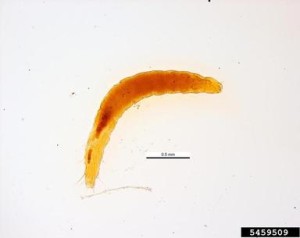Why Didn’t Our Flea Treatment Work?
By Chris Williams on September 5, 2014.
We had our home treated for fleas about a month ago. We also had the dog treated by the vet. Everything has been fine until a couple of days ago. Now I’m noticing adult fleas again. They’re not on the dog but they are trying to get on us. How come the flea treatment seemed to work for a while but now we have fleas again? A. C. M, Blackstone, MA
It’s Very Difficult to Break the Flea Life Cycle

Cat Flea Larva
Even if you successfully kill the adult fleas on your pet, there are still the flea eggs and larvae that are developing off of your pet in your home. That’s where a professional exterminator comes into the picture. We treat the areas in your home where fleas are developing to kill larvae before they turn into biting adult fleas. I’m guessing that your exterminator’s treatment did kill most of the developing fleas but that you are now being attacked by a few that were missed by the treatment and have since turned into hungry adults.
Flea larvae tend to burrow way down to the base of carpeting where they wrap themselves around the fibers. It’s hard to get pesticide spray to penetrate far enough to reach them. Sometimes, despite exterminators’ best efforts, flea eggs and larvae deep in carpeting or upholstery, and flea pupae inside protective cocoons are not affected by the spray.
An IGR Gives Long Term Control of Fleas
I’m assuming that you had a professional exterminator treat your home, but I’m also guessing that they did not use an IGR. Because we know that our spray treatment may not reach all of the developing flea eggs and larvae, we use a two-pronged approach. We add an IGR, or insect growth regulator, to our flea treatment. The IGR doesn’t kill fleas outright, but affects their growth to keep flea eggs from hatching and flea larvae from turning into adult fleas. An IGR breaks the fleas’ life cycle and gives extra assurance that fleas can’t redevelop in your home. See IGRs Used Early Stop Flea Development For Good.
You Have to Treat All the Flea “Hot Spots”
Flea larvae develop where your pet spends most of its time, that’s usually in the pet’s bed (or your bed!), or on the sofa, or under the table, etc. A good flea technician will do a thorough inspection in your home and will ask you about places where your pet spends its time. There are probably lots of these flea hot spots in your home and it’s important that they are all discovered and treated. Missing just one of these areas can mean that fleas can eventually repopulate your home.
Image: Pest and Diseases Image Library, Bugwood.org